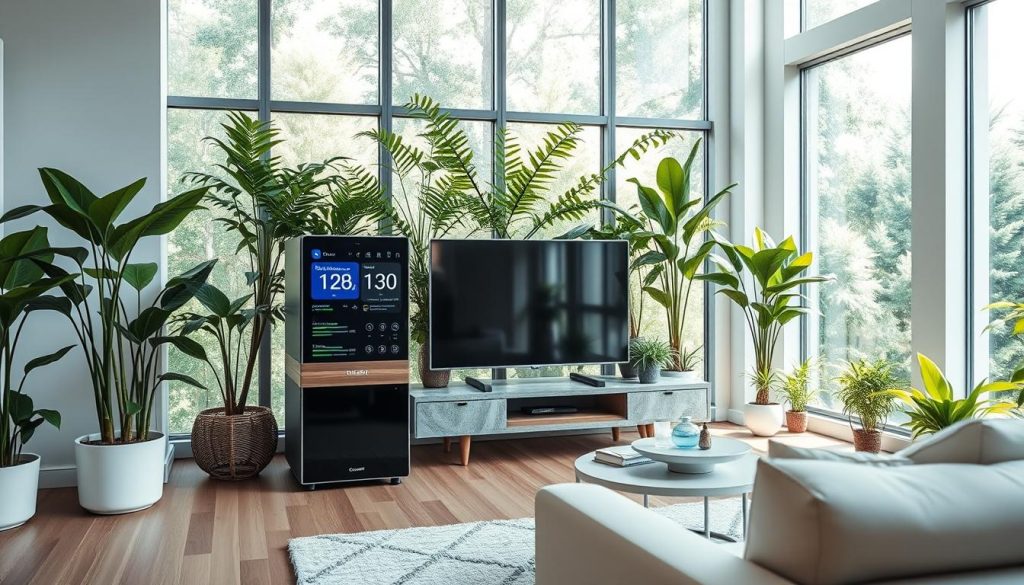Sănătatea ta, Natură Curată: Cum să Eviți Poluarea din Casă

În lumea modernă, trăim mult timp în interior. Acesta poate fi acasă, la birou sau în alte spații închise. Calitatea aerului din aceste locuri poate fi mai slabă decât în exterior, expunându-ne la poluanți.
Prin urmare, putem face multe pentru a avea un mediu de viață mai sănătos. Alegem simple strategii pentru a crea un spațiu curat pentru noi și pentru familie.
Acest articol vă va arăta cum să protejați sănătatea prin calitatea aerului din interior. Vom vorbi despre sursa de poluare și pașii pentru a evita această problemă. De la plantelor de purificare a aerului la ventilație naturală, vom discuta soluții practice.
Puncte Cheie
- Înțelegerea impactului calității aerului din interior asupra sănătății și bunăstării generale.
- Identificarea principalilor poluanți din interiorul locuințelor și a efectelor lor asupra sănătății.
- Strategii de ventilație naturală pentru îmbunătățirea circulației aerului în casă.
- Utilizarea plantelor de purificare a aerului pentru a reduce substanțele toxice din interior.
- Adoptarea unor practici de curățenie ecologice și a tehnologiilor inteligente pentru controlul calității aerului.
Understanding Indoor Air Quality and Its Impact on Health
Our homes should be a safe haven where we can breathe easily. But, indoor air can be more polluted than outside air. This poses serious health risks. It’s important to know about indoor air pollutants, their health effects, and how they affect air quality.
Common Indoor Air Pollutants
Many pollutants can contaminate indoor air. These include:
- Volatile organic compounds (VOCs) from household cleaners, paints, and furniture
- Particulate matter such as dust, pet dander, and smoke
- Carbon monoxide from malfunctioning appliances
- Radon, a naturally occurring radioactive gas
- Mold and mildew growth due to excess moisture
Health Effects of Poor Indoor Air Quality
Being exposed to these indoor air pollutants can cause health problems. Symptoms range from headaches to serious diseases. Keeping good air quality in our homes is crucial.
Vulnerable Groups and Risk Factors
Some people are more at risk from bad indoor air quality. These include children, the elderly, and those with health issues. Knowing these risk factors helps us protect our families better.
By tackling indoor air quality issues, we can make our homes healthier. Next, we’ll look at common sources of indoor air pollution and how to fight them.
Sources of Indoor Air Pollution in Modern Homes
Today, our homes are more than just places to live. They can also hide household pollutants and indoor pollution sources that affect our air quality. Knowing about the common modern home contaminants in our homes is key to a healthier living space.
Building materials like paints, varnishes, and adhesives can release harmful VOCs over time. Also, furniture, carpets, and cleaning products can add to these pollutants. These substances can harm our health.
Our daily habits, such as smoking, cooking, and using candles or incense, can also pollute the air. They release harmful particles, carbon monoxide, and chemicals. Pet dander, dust mites, and mold can also affect our air quality and health.
| Household Pollutant | Common Sources | Potential Health Effects |
|---|---|---|
| Volatile Organic Compounds (VOCs) | Building materials, furniture, cleaning products | Respiratory irritation, headaches, nausea, cancer |
| Particulate Matter | Cooking, smoking, candles, incense | Respiratory problems, cardiovascular disease |
| Carbon Monoxide | Faulty fuel-burning appliances, vehicle emissions | Headaches, dizziness, nausea, brain damage, death |
| Mold and Mildew | Excessive moisture, poor ventilation | Respiratory problems, allergic reactions, asthma |
By understanding these modern home contaminants and their sources, we can work to improve our indoor air quality. This helps create a healthier home environment for everyone.
Natural Ventilation Strategies for a Healthier Home
Keeping our indoor air clean is key to our health. Natural ventilation is a top way to do this. It uses air flow and smart window placement to cut down on indoor pollutants.
Window Positioning Techniques
Where and how you place your windows matters a lot for natural ventilation. Here are some tips:
- Put windows on opposite walls for a cross-breeze and better air flow.
- Install windows at different heights to use the stack effect. Warm air rises and exits through higher windows.
- Choose operable windows that you can adjust to control airflow.
Creating Cross Ventilation
Cross ventilation is a strong strategy for natural ventilation. It involves placing windows and doors to let fresh air in. This method improves air quality and cuts down on pollutants.
Optimal Times for Natural Ventilation
Timing natural ventilation right can make it even better. The coolest hours, like early morning and late evening, are best. This is when the air is freshest. Try to avoid times when pollution is high or air quality is poor.
Using these natural ventilation methods can make your home healthier and more comfy. It’s good for you and the planet.
Essential Air Purifying Plants for Your Home
Breathing clean air at home is key for our health. But did you know some plants can purify the air naturally? Meet air purifying plants – nature’s way to clean our indoor air.
These amazing indoor plants can remove harmful toxins and pollutants. They make your home a healthier, more natural air cleaner. From the NASA-recommended spider plant to the tough peace lily, let’s look at some top air purifying plants for your home.
- Spider Plant: A versatile and easy-to-grow plant that can remove formaldehyde, xylene, and toluene from the air.
- Peace Lily: Known for its ability to remove ammonia, benzene, and trichloroethylene from the atmosphere.
- English Ivy: An excellent choice for filtering out formaldehyde, xylene, and toluene.
- Snake Plant: Also called Mother-in-Law’s Tongue, this resilient plant can remove benzene, formaldehyde, trichloroethylene, and xylene.
- Philodendron: A lush, trailing plant that effectively removes formaldehyde from the air.
When picking air purifying plants for your home, think about their size, light needs, and care. Placing these indoor plants around your home can greatly improve air quality. It makes your home healthier and more lively for you and your family.
“Bringing nature indoors through air purifying plants is a simple and effective way to breathe easier at home.”
Cum să Identifici Poluarea din Casa Ta
Calitatea aerului din casă este crucială pentru sănătatea ta și a familiei. Dar, uneori, e greu să găsești unde provine poluarea. Vom arăta cum poți detecta poluarea interioară folosind monitoare de calitate a aerului și evaluare profesională.
Semne Comune ale Poluării Interioare
Unele semne ale unei calități slabe a aerului interior includ:
- Mirosuri neplăcute sau persistente
- Acumularea de praf și murdărie în exces
- Prezența mucegaiului sau a umezelii
- Simptome de sănătate, cum ar fi iritarea ochilor, a gâtului sau dureri de cap
Utilizarea Monitoarelor de Calitate a Aerului
Un monitor de calitate a aerului poate da informații utile despre poluarea din casă. Aceste dispozitive detectează particule fine, compuși organici volatili, dioxid de carbon și alți contaminanți. Astfel, vei avea o imagine clară a calității aerului.
Opțiuni de Evaluare Profesională
Dacă problemele de poluarea interioară persistă, e bine să apelezi la un expert. Un profesionist în calitatea aerului poate face teste avansate. El va identifica sursele de poluare și va oferi soluții pentru a îmbunătăți aerul din casă.
Identificând corect problemele de calitate a aerului interior, poți lua măsuri proactiv. Folosind observații personale, instrumente de monitorizare și evaluări profesionale, vei putea combate eficient poluarea din interiorul casei tale.
Eco-Friendly Cleaning Solutions and Practices
In our quest for a healthier home, eco-friendly cleaning is key. By using green cleaning, we cut down on indoor air pollution and lessen our environmental footprint. Let’s look at simple ways to clean your home without harming your health or the planet.
Natural Cleaning Recipes
Forget harsh chemicals and try homemade, non-toxic cleaners. You can make effective cleaners with common items like baking soda, vinegar, and essential oils. These green cleaning recipes are soft on surfaces and the environment.
- All-Purpose Cleaner: Mix equal parts of water and white vinegar in a spray bottle. Add a few drops of lemon or lavender essential oil for a fresh scent.
- Glass Cleaner: Combine equal parts of water and white vinegar in a spray bottle. Wipe clean with a microfiber cloth.
- Toilet Cleaner: Sprinkle baking soda into the bowl, followed by a few splashes of white vinegar. Let it fizz, then scrub and flush.
Sustainable Housekeeping Practices
There’s more to sustainable housekeeping than DIY cleaners. Choosing non-toxic cleaners and reducing single-use plastics are big steps. Every small action counts.
- Invest in reusable cleaning tools like microfiber cloths, mops, and refillable spray bottles.
- Opt for green cleaning products certified by recognized eco-labels, such as USDA Organic or EPA Safer Choice.
- Reduce the use of disposable paper towels by switching to washable cleaning rags or a reusable drying system.
- Properly dispose of any hazardous cleaning chemicals, and recycle containers whenever possible.
By adopting these eco-friendly cleaning solutions and practices, you can make your home healthier and greener for you and your family.
| Conventional Cleaners | Eco-Friendly Alternatives |
|---|---|
| Ammonia-based products | Vinegar, baking soda, castile soap |
| Chlorine bleach | Hydrogen peroxide, oxygen bleach |
| Artificial fragrances | Essential oils, natural scents |
| Single-use plastic bottles | Refillable containers, concentrated formulas |

“Cleaning should not cost the earth. With a few simple changes, we can enjoy a clean home while protecting the environment.”
Managing Humidity Levels to Prevent Mold Growth
Keeping your indoor air healthy is key. Mold grows in damp places. It can cause breathing problems and allergies. By controlling humidity, you can keep your home safe.
Ideal Humidity Ranges
The best humidity for indoors is between 30% and 50%. Too low can dry out your skin and hurt your breathing. Too high invites mold and mildew. Staying in this range keeps your home comfortable and healthy.
Dehumidification Methods
- Get a good dehumidifier to pull out extra moisture. Choose one that saves energy and has adjustable settings.
- Boost ventilation by opening windows and using fans. This helps keep humidity balanced naturally.
- Fix any leaks or cracks to stop outside moisture from getting in. Weatherproofing helps keep humidity right.
- Use moisture-resistant materials for renovations. Some materials are less likely to grow mold.
Using these methods to control humidity makes your home healthier. It keeps mold away and makes your living space more comfortable.
“Proper humidity control is the key to preventing mold growth and maintaining excellent indoor air quality.”
Smart Home Technology for Air Quality Control
In today’s world, smart home tech is changing how we keep our air clean. Smart air purifiers, IoT air quality devices, and home automation systems let us control our air. This makes our homes healthier and easier to breathe in.
These devices use sensors and algorithms to watch and clean the air. They track things like dust, chemicals, and moisture. This way, they adjust to keep the air in our homes just right.
IoT air quality devices work with our smart homes. We can check and change the air quality with our phones or voice commands. It’s easy to make our air fit our lifestyle.
Using smart home technology for air makes life easier and healthier. We get alerts when the air gets bad. We can also set the purifiers to work on their own. This keeps our homes clean and comfy all year.
“Smart home technology has revolutionized the way we manage indoor air quality, empowering us to create cleaner, more breathable spaces with just a few taps on our phones.”
The need for clean indoor air is growing. Smart air purifiers, IoT air quality devices, and home automation are key to this. They help us have cleaner, healthier homes with just a few taps.

Seasonal Maintenance Tips for Clean Indoor Air
Keeping indoor air clean is a year-round task. But, seasonal changes bring their own challenges. By using smart seasonal maintenance, you can keep your home’s air quality great all year.
Spring Cleaning Strategies
When the weather gets warmer and windows open, it’s time for spring cleaning. Focus on deep cleaning, decluttering, and removing winter dirt. Make sure to clean your ventilation systems, like HVAC filters and air ducts, to remove dust and debris.
This will boost seasonal air quality and make your home’s air flow better.
Winter Ventilation Solutions
In the cold months, winter ventilation is key since homes are sealed to stay warm. Create a routine of opening windows and doors for fresh air. This helps prevent indoor pollutants and keeps healthy indoor air quality all winter.
Also, think about getting a top-notch air purifier to help with winter ventilation. These devices can clear out airborne pollutants, keeping your home healthy even with closed windows.
By adding these seasonal air quality tips to your home care, you’ll have clean, fresh air all year. This improves your family’s health and your home’s well-being.
Conclusion
We’ve looked into why indoor air quality improvement is key for a healthy home. We’ve covered common air pollutants and how to reduce them. Now, you have the tools to make your home safer and cleaner.
Using natural ventilation, air-purifying plants, and eco-friendly cleaners can make a big difference. Smart home tech and regular maintenance also help improve air quality. These steps can make your home healthier.
Keeping your home clean is good for you and the planet. By using these green solutions, you help reduce pollution. Start making your home cleaner and healthier today. Enjoy the benefits for yourself and future generations.
FAQ
What are the most common indoor air pollutants?
Common indoor air pollutants include dust, pollen, mold, and volatile organic compounds (VOCs). They also include carbon monoxide and secondhand smoke.
How does poor indoor air quality affect health?
Poor indoor air quality can cause health issues. These include respiratory problems, headaches, and allergies. It can also lead to long-term conditions like asthma and lung disease.
Which groups are most vulnerable to the effects of indoor air pollution?
Children, the elderly, and people with pre-existing medical conditions are most at risk. They are more likely to suffer from the negative health effects of indoor air pollution.
What are some effective natural ventilation strategies for improving indoor air quality?
Natural ventilation strategies include proper window positioning. They also involve creating cross-ventilation and opening windows during optimal times. This maximizes air circulation.
Which air-purifying plants are most effective for improving indoor air quality?
Some of the most effective air-purifying plants include English ivy, snake plant, peace lily, and spider plant. These plants help clean the air.
How can I identify potential sources of indoor air pollution in my home?
Signs of indoor air pollution include musty odors and visible mold. Excessive dust and increased allergy or respiratory symptoms are also signs. Using air quality monitors and seeking professional assessments can help identify pollution sources.
What are some eco-friendly cleaning solutions that can improve indoor air quality?
Eco-friendly cleaning solutions include homemade products. These are made with ingredients like vinegar, baking soda, and essential oils. They are effective and safer for indoor air quality.
How can I manage humidity levels to prevent mold growth?
To prevent mold growth, maintain indoor humidity levels between 30-50%. Using dehumidifiers and ensuring proper ventilation can help manage humidity levels effectively.
What smart home technologies can help monitor and improve indoor air quality?
Smart air purifiers, IoT-enabled air quality sensors, and home automation systems can help. They provide real-time data and personalized recommendations to improve indoor air quality.
What are some seasonal maintenance tips for maintaining clean indoor air?
Seasonal maintenance tips include spring cleaning strategies. These strategies help remove dust and allergens. Addressing ventilation challenges during the winter months is also important to ensure proper air circulation.













